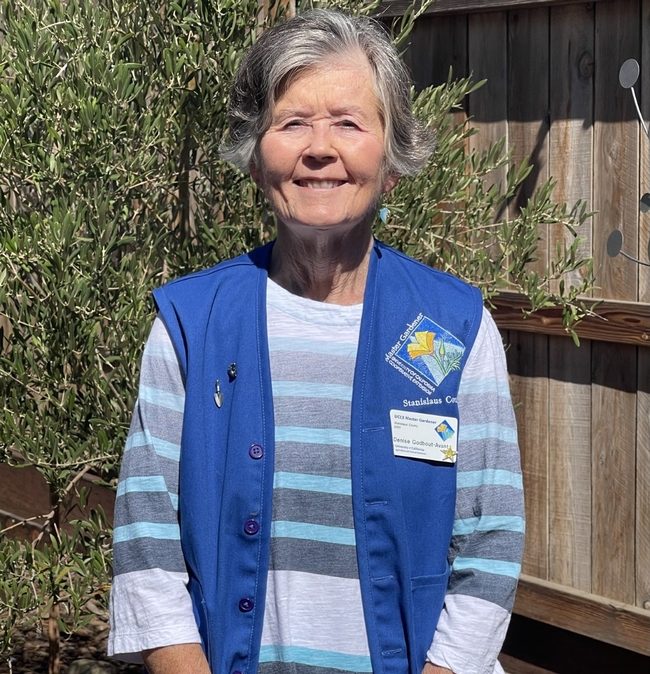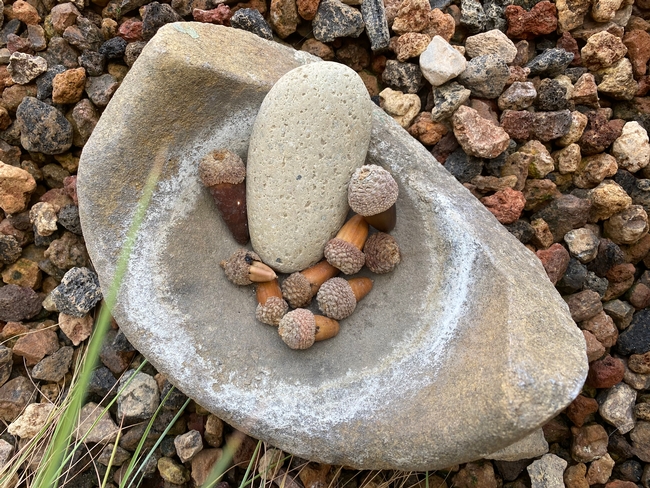
Valley Oak (Querus lobata):
The acorns were a staple food, which was leached (rinsed with water) to remove the bitterness, and ground into flour with mortar and pestles. The ground acorns were used in stews/soups, pancakes/tortillas, mush, or layered into pits and cooked with other plants and meats. Oak galls were squeezed to make a blue-black ink for tattoos and tannins were used to make dyes and decorate animal skins.
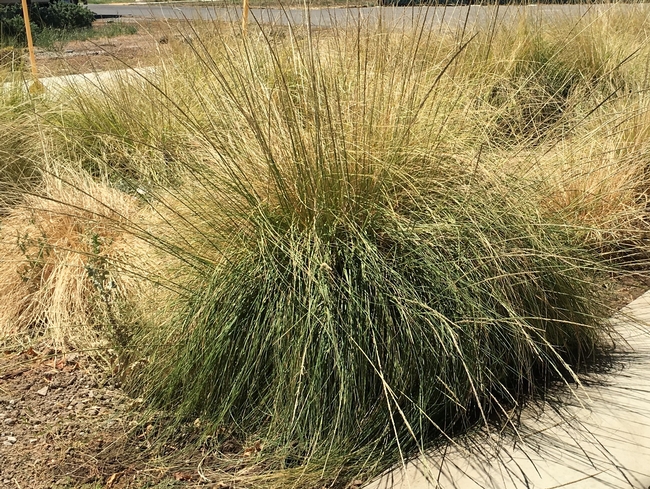
Deer Grass (Muhlenbergia rigens):
A major grass for creating beautiful, sometimes water-tight baskets to cook food, to carry and store food and other items. Stalks were generally harvested in the spring when easy to pick, then wrapped to keep straight and allowed to cure for a year. They were often soaked prior to weaving into basket. About 1600 stalks would be needed to make one basket.
One of the most beautiful California grasses, this easy-to-grow plant attracts butterflies in the spring with its cream-colored flowers and seed-eating birds in the summer.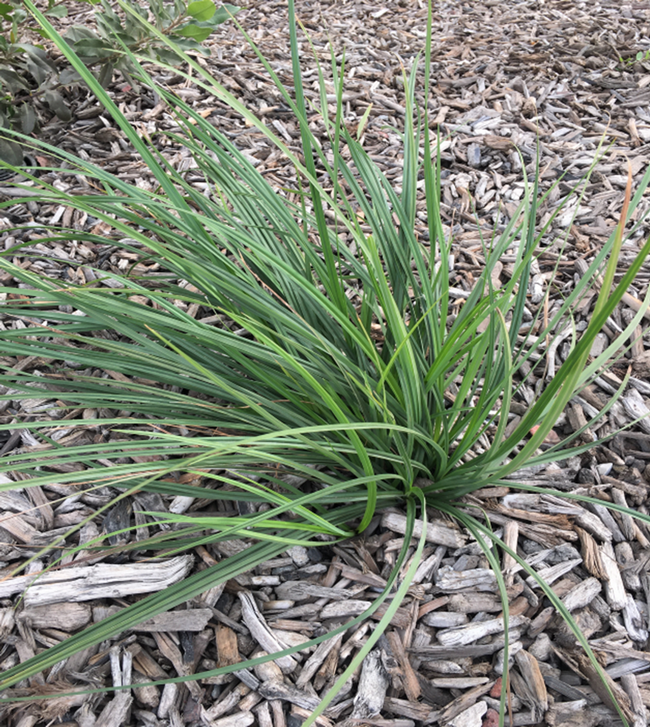
Santa Barbara Sedge (Carex barbarae):
The rhizomes (underground stems which generally grow horizontally) provided the strongest threads for basket making. The people would manage the rhizome growth by cleaning the soil of anything that might obstruct the growth (i.e., rocks) to allow the rhizomes to grow long and straight. An evergreen grass, the summer flowers range from cream, red and purple colors, which attract butterflies.
Toyon, aka California Holly (Heteromeles arbutifolia):
The wood from this sturdy shrub had many uses including tools, games/toys, fuel for smoking fish, and religious ceremonies. The red berries produced in the fall which were eaten after roasting over coals or dried in the sun.
An evergreen shrub, the summer white flowers attract bees and butterflies. Birds love the berries.
Blue Elderberry (Sambucus cerulea):
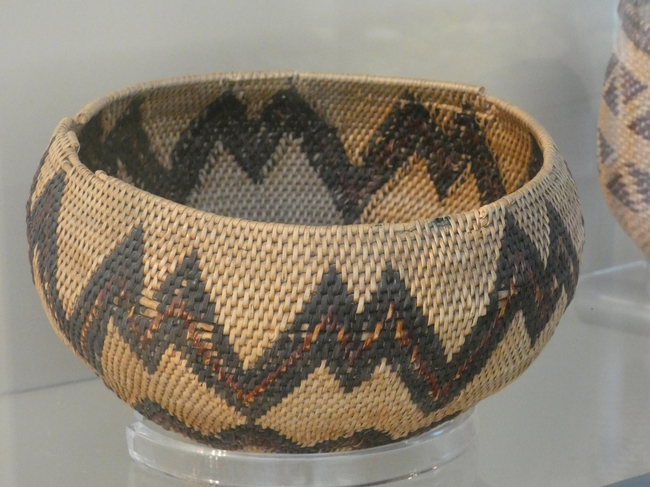
This tough, easy-to-grow shrub or tree is dormant in the winter. The spring and summer blooming cream or yellow flowers attract bees and butterflies, with their berries being an important food source to many birds.
Manzanita (Arctostaphylos manzanita):
Its distinctive red wood which was sometimes used to dry and smoke fish. The fruit was gathered in summer, then dried and ground to make coarse meal which would be mixed with a little water during winter months or made biscuits. They would make tea with the berries and tips of the branches, which apparently was a pleasant drink.
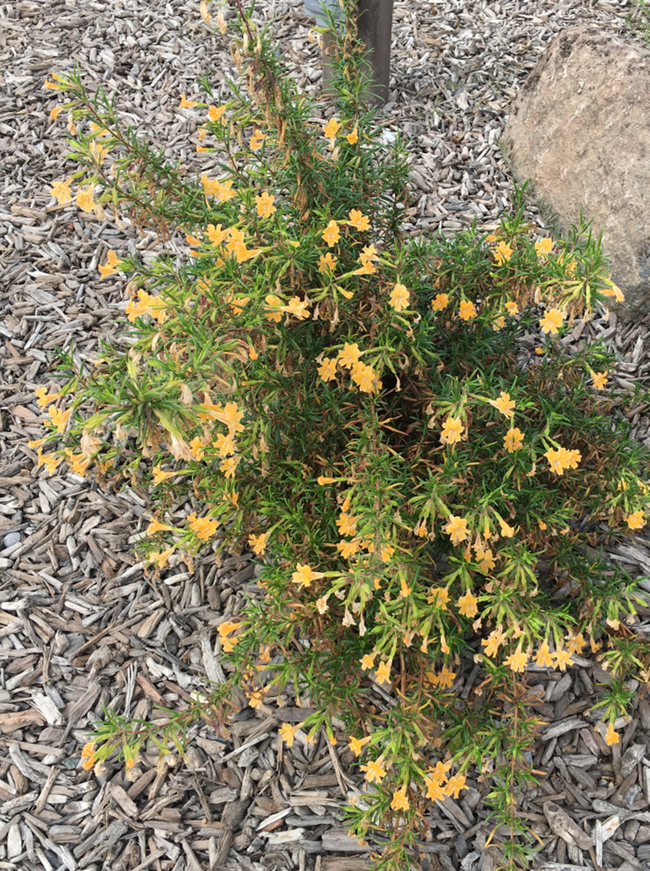
Sticky Monkey Flower (Mimulus aurantiacus):
The seeds were used as a food source. They were gathered, parched, ground, and added to foods or eaten by the handful. Flowers were used as décor after drying, made into wreaths, and used in religious ceremonies. The roots and leaves were used for medicinal purposes.
This drought-tolerant, evergreen shrub blooms in the spring, summer, and fall. The bright yellow tubular flowers attract hummingbirds, bees, and butterflies. Autumn seeds attract small birds.
Whenever I see any of these California native plants, I think of how the indigenous people of California used these plants over thousands of years. By growing them in our gardens, we honor that history, help the survival of these plants which provide food sources for so many birds, bees, and butterflies, reduce water usage, bring variety to our gardens, and joy to our spirits with their beauty.
Learn more at the Library - Take a free class!
This September, our UC Master Gardeners will present on the topic, "CA Native Plants" at 9 Stanislaus County Library locations. Visit our Calendar at https://ucanr.edu/sites/stancountymg/Calendar/ for dates, times, and locations.
Upcoming Workshop
On Saturday, October 7, 2023, we are offering our "The New Front Yard" workshop. Topics include drip irrigation, converting your yard to native plants, and how to garden for year-round bloom! Stay tuned for the registration announcement.
Resources:
- Enough For All: Foods of My Dry Creek Pomo and Bodega Miwuk People by Kathleen Rose Smith
- The Real California Cuisine: A Treatise on California Native-Plant Foods by Judith Larner Lowry
- Tending the Wild: Native American Knowledge and the Management of California's Natural Resources by M. Kat Anderson
- Indian Summer: A True Account of Traditional Life Among the Choinumni Indians of California's San Joaquin Valley
- Great Valley Museum of Natural History at Modesto Junior College's exhibit on Yokuts
- California Native Plant Society: https://www.calscape.org/
Acknowledgment: Lillian Vallee, English professor emeritus, Modesto Junior College, who has shared her passion and knowledge with me over the years of California native plants and their historical uses by the California native people.
Denise Godbout-Avant has been a UC Cooperative Extension Master Gardener in Stanislaus County since 2020.
- Author: Denise Godbout-Avant
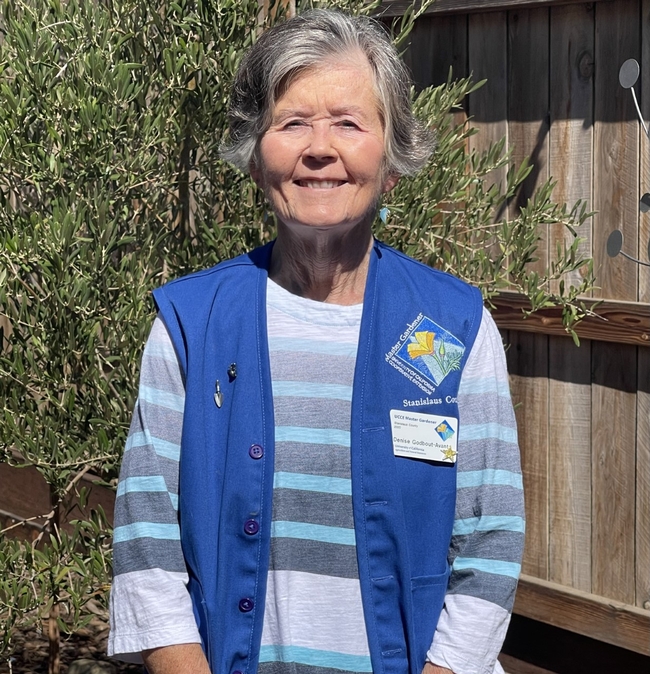
There are three groups of plants that attract birds and each group draws different types of birds: Nectar plants, plants that provide seeds or nuts, and plants that produce berries or fruit. Many plants will provide more than one source of food, i.e., nectar in the spring and berries in autumn.
Here is a list of a few favorite native plants in each group and some of the birds they may attract.
Hummingbirds and Nectar
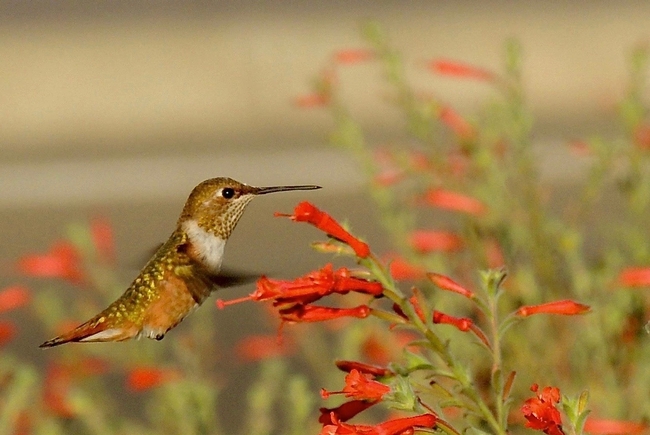
Hummingbirds prefer tubular shaped flowers that fit the length of their beak, and are bright in color, particularly red. Native salvias (sages), penstemon, columbine, and honeysuckle all serve up nectar for hummingbirds.
- Sages (Salvias): There are about 18 sages native to California, with Hummingbird sage (Salvia spathacea) being one of them. The common name says it all! Fruity scented dark rose-lilac blossoms appear in March – May. It also produces autumn seeds that attract birds such as sparrows and finches.
- Western Redbud (Cercis occidentalis). A small deciduous tree or shrub found in the foothills and mountains of California with distinctive shiny heart-shaped leaves. The showy bright pink or magenta flowers develop in the later winter and spring, growing in clusters all over the shrub, making the plant very colorful and noticeable in the landscape. Goldfinches and sparrows will feed on seeds produced in the fall.
- California Fuchsia (Epilobium canum). There's probably no better California native plant for attracting hummingbirds. A perennial plant, it blooms a bright profusion of scarlet flowers in spring and summer, and is often the only native California flowering plant blooming at the height of summer.
Birds That Eat Seeds
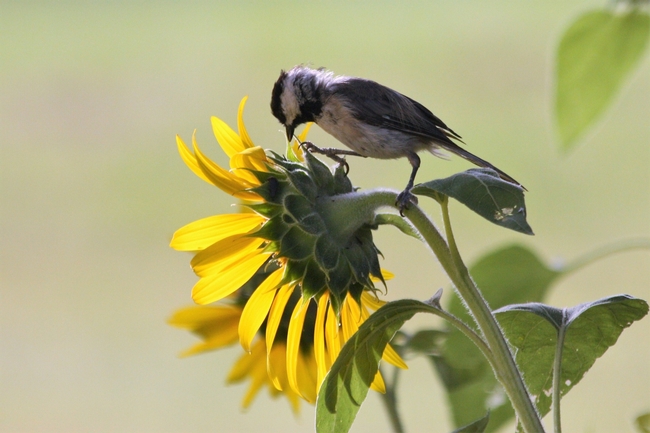
- Bush sunflower (Encelia californica), commonly referred to as "California bush sunflower.” With abundant bright yellow daises, it is beautiful in late winter through summer. Attracts goldfinches, sparrows, orioles, crows, Scrub jays, grosbeaks.
- California aster (Symphyotrichum chilense). A member of the Asteraceae family it is native to western North America. The summer blooming flowers come in blues, purples and yellow colors. It is also a host plant for the Northern Checkerspot, Field Crescent and Pearl Crescent butterflies.
- Deergrass (Muhlenbergia rigens), also known as Meadow Muhly and Deer Muhly, is a summer-growing, perennial bunchgrass whose seeds attracts woodpeckers, finches, grosbeaks, crows and jays.
Berry Plants are Important to Birds
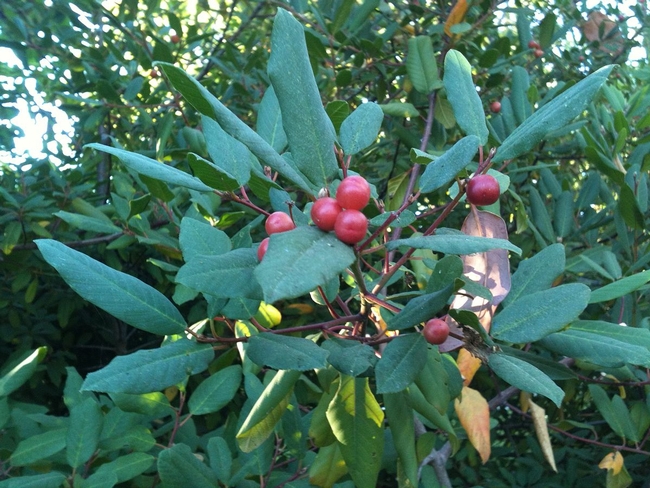
Many shrubs and small trees provide berries that ripen at different times, so providing a seasonal variety, such as cherries for birds during the breeding seasons of spring and summer, and holly in winter, helps sustain birds throughout the year.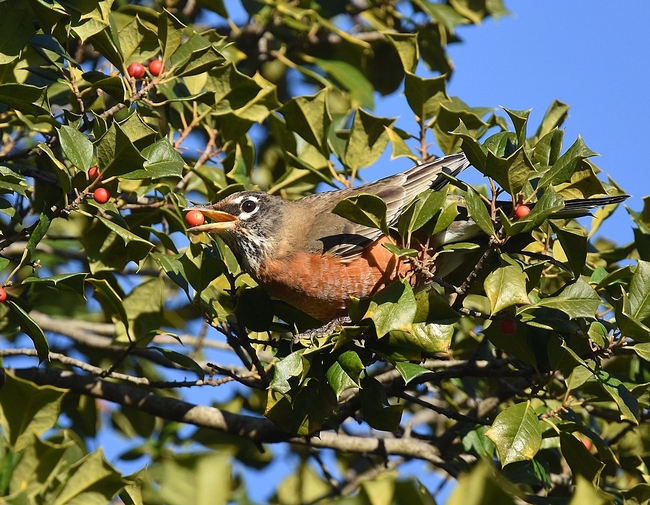
- Golden Currant (Ribes aureum). A deciduous plant that blooms in late winter and spring with golden yellow flowers that attract hummingbirds. The ripe berries in autumn are amber yellow to black in color, are edible, and attract a wide range of birds. There are two main varieties: Ribes aureum var. aureum and Ribes var. gracillimum.
- Blue Elderberry (Sambucus Mexicana). Also known as Mexican elderberry, the berries from elderberries are one of the most important sources of food for birds in California. Native from Oregon to Baja all the way to western Texas, it has cream or yellow flowers in the spring and purple berries in the fall.
- Toyon (Heteromeles arbutifolia). Toyon is a beautiful perennial chapparal shrub native throughout the western part of California and the Sierra foothills. It is also known by the common names Christmas berry and California holly from the bright red berries it produces during the winter months, which are produced in large quantities, maturing in the fall and persisting well into the winter. Note: the berries are toxic to humans in large amounts.
- California False Buckthorn (Frangula californica). This perennial, evergreen shrub is also known as Coffeeberry due to its berries containing seeds that resemble coffee beans. The shrub produces small, greenish white flowers in the summer, followed by dark berries that are sought after by birds.
By providing a variety of native plants that produce nectar, seeds and berries to attract different types of birds, you'll be providing a healthy haven for birds all year round, along with many other species of pollinators such as bees and butterflies!
Denise Godbout-Avant has been a UCCE Stanislaus County Master Gardener since 2020.
Resources
California Native Plant Society https://www.calscape.org/ and garden planner https://gardenplanner.calscape.org/
A list of plants that naturally attract California Birds to your Garden https://www.laspilitas.com/bird.htm
Audubon native plants database https://www.audubon.org/native-plants
- Author: Anne Schellman
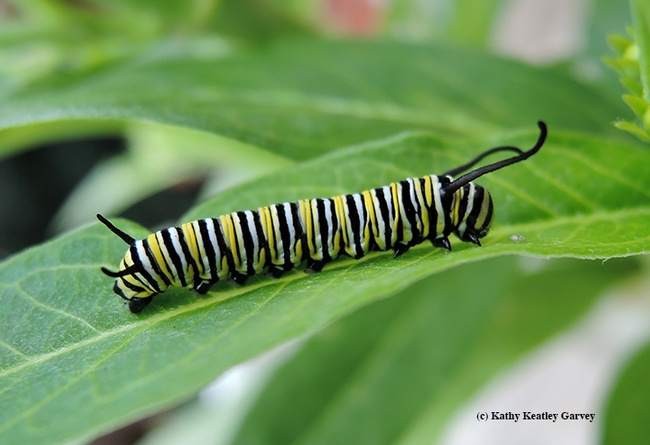
Thanks to donations from readers like you, our Pollinator Gardening project raised a total of $1,000. This amount will go towards our garden signage and pathway. We've sent out narrowleaf milkweed seed packets, which you should receive in the mail soon. Now is a great time to plant these seeds! As you've read, milkweed is the sole food source for monarch butterfly caterpillars. We are excited about the possibility of seeing these gorgeous yellow, black, and white caterpillars in our garden in the near future!
Next steps for the Pollinator Garden include adding mulch (next week!), planting more plants, and figuring out best ways to label the plants. Many of the native plants have their original name tags, so feel free to stop by. The garden is located on the west side of the Stanislaus Building at the Ag Center.
In the coming weeks we will add pollinator plants that are not native, but that have the same water requirements.
If you visit, don't let the lack of pathways stop you! Stroll right through and take a look. The plants are small now, but we expect spring blooms, and in another year they will have doubled in size. We will continue to update you on the progress of the garden
Missed Giving Tuesday but still want to give? You still can. Please make checks out to:
UC Regents and send to:
UCCE Stanislaus County Master Gardener Program
3800 Cornucopia Way, Ste A
Modesto, CA 95358
We still have plenty of milkweed seed packets left to send.
Thank you!
- Author: Anne Schellman
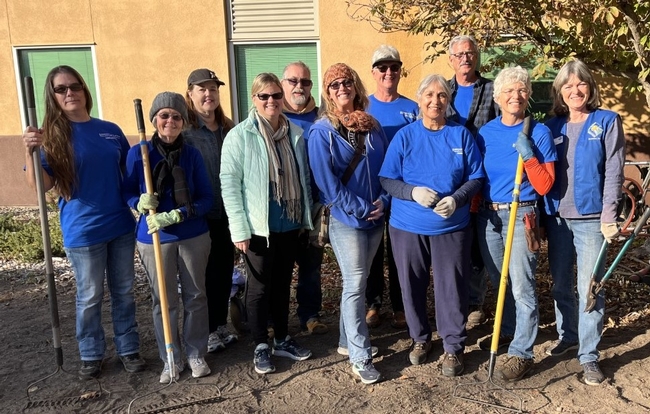
Currently, we are installing demonstration gardens to be used as outdoor classrooms that the public can visit anytime, and we need your help!
Pollinator Garden
Our Pollinator Garden is in the installation stage, and we could not be more thrilled. Currently, the irrigation and native plants are going in. Our Master Gardener volunteers were hard at work leveling, raking, and planting just this week.
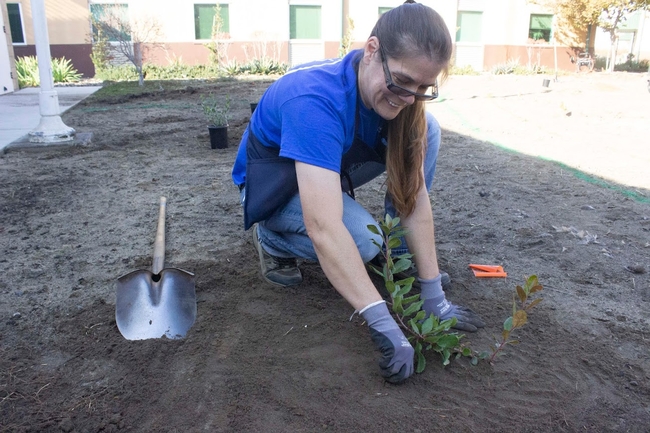
A big “thank you” to the West Resource Conservation District that helped us prepare the garden site, and to our local North San Joaquin Valley Chapter of the California Native Plant Society https://nsj.cnps.org/ for purchasing and donating the native plants! Many of these species are unusual and not normally found in the landscape. Although newly planted, everyone is welcome to stop by and visit*.
Your Funds Help Make this Garden Happen
Help make this demonstration garden come to life! Funds will be used to purchase additional plants, tools, and educational signage. Our big funding goal is a decomposed granite walkway. This is a pricey item, which can cost several thousand dollars. The benefits are a pathway accessible to everyone that avoids runoff and allows good drainage.
How to Give
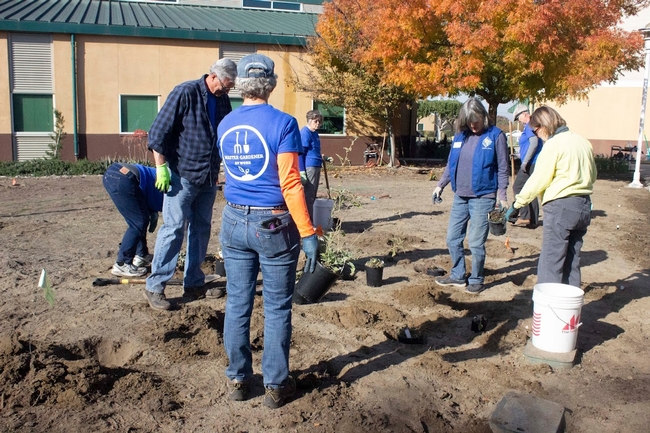
If you prefer to donate by check, please make it out to: UC Regents and send to:
UCC Stanislaus County Master Gardener Program
3800 Cornucopia Way, Ste A
Modesto, CA 95358
Thank you
We look forward to meeting you in the near future in our “outdoor classroom” aka Pollinator Garden for classes on pollinators, California native plants, and how you can support them in your backyard garden, patio, apartment, or classroom.
* Our gardens are located at the Ag Center complex on the corner of Crows Landing and Service Roads in Modesto at 3800 Cornucopia Way, 95358. The Pollinator Garden is on the east side of the Stanislaus building, while the Sensory Garden is on the west side.

